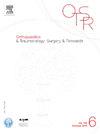髋关节置换术:治疗复杂髋关节假体感染的有效方法?
IF 2.2
3区 医学
Q2 ORTHOPEDICS
引用次数: 0
摘要
引言:复发性髋关节假体感染(PJI)的治疗具有挑战性。髋关节切除术是复杂PJI的最后选择。主要目的是前瞻性评估髋关节置换术患者的中期感染性和功能性PJI预后。假设:在复杂的多次手术的PJI中,髋关节切除术可以治愈感染,而不会对髋关节功能产生重大影响,这往往已经非常有限。材料和方法:这项在法国骨关节感染转诊中心进行的前瞻性队列研究包括2004年至2019年接受髋关节切除术治疗的所有髋关节PJIs。患者随访至少2年,记录以下事件:再感染,包括复发或新感染,以及pji相关死亡。采用改良的Merle d' aubigne - postel (mMAP)评分评估髋关节功能状态。主要终点为2年无事件生存期(EFS)。次要结果是4年和6年的EFS率和2年的髋关节功能状况。结果:我们纳入了30例患者:中位年龄65岁;39%的女性。中位[IQR] PJI持续时间为15[4-39]个月,患者在切除关节置换术前中位接受了5次手术。2年无再感染生存率为89.2% (95% CI: 70.2 ~ 96.4)。在中位随访70[32-103]个月后,我们观察到:1例复发,4例新感染,7例机械原因修复,1例pji相关死亡。术后2年mMAP评分中位数为12,而术前为7;减轻疼痛是关节置换术的主要益处。讨论:髋关节置换术可以实现脓毒症和疼痛控制,对于复杂或复发性髋关节PJIs患者来说,这是一种有价值的最后一线抢救策略。证据等级:II;单中心前瞻性队列研究。本文章由计算机程序翻译,如有差异,请以英文原文为准。
Hip-resection arthroplasty: A valuable treatment for complex hip prosthetic joint infection?
Introduction
Management of recurrent hip prosthetic joint infection (PJI) is challenging. Hip-resection arthroplasty is a last-choice rescue strategy for complex PJI. The main objective was to assess prospectively the mid-term infectious and functional PJI outcomes of patients managed with hip-resection arthroplasty.
Hypothesis
In complex multi-operated PJI, hip-resection arthroplasty may cure the infection without any major impact on hip function, which is often already very limited.
Material and methods
This prospective cohort study conducted in a French Referral Center for bone-and-joint infections included all hip PJIs treated with hip-resection arthroplasty from 2004 to 2019. Patients were followed for at least 2 years, with recording of the following events: reinfection, including relapse or new infection, and PJI-related death. Hip functional status was assessed with the modified Merle d’Aubigné-Postel (mMAP) score. The primary outcome was 2-year event-free survival (EFS). The secondary outcomes were the 4- and 6-year EFS rates and hip functional status at 2 years.
Results
We included 30 patients: median age, 65 years; 39% women. Median [IQR] PJI duration was 15 [4–39] months and patients underwent a median of 5 surgical procedures before resection arthroplasty. The 2-year reinfection free-survival was 89.2% (95% CI: 70.2–96.4). After a median follow-up of 70 [32–103] months, we observed: 1 relapse, 4 new infections, 7 revisions for mechanical reasons and 1 PJI-related death. Median mMAP score 2 years postsurgery was 12, versus 7 before; pain reduction was the main benefit of resection arthroplasty.
Discussion
Hip-resection arthroplasty achieves sepsis and pain control, and can be a valuable last-line rescue strategy for patients with complex or recurrent hip PJIs.
Level of evidence
II; monocentric prospective cohort.
求助全文
通过发布文献求助,成功后即可免费获取论文全文。
去求助
来源期刊
CiteScore
5.10
自引率
26.10%
发文量
329
审稿时长
12.5 weeks
期刊介绍:
Orthopaedics & Traumatology: Surgery & Research (OTSR) publishes original scientific work in English related to all domains of orthopaedics. Original articles, Reviews, Technical notes and Concise follow-up of a former OTSR study are published in English in electronic form only and indexed in the main international databases.

 求助内容:
求助内容: 应助结果提醒方式:
应助结果提醒方式:


